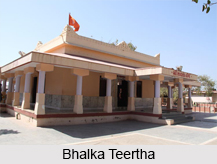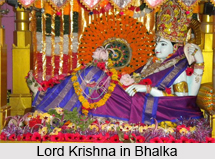 Bhalka Tirtha which is also known Bhalka Pilgrimage is a famous pilgrimage tourism destination in Gujarat.
Bhalka Tirtha which is also known Bhalka Pilgrimage is a famous pilgrimage tourism destination in Gujarat.
Location of Bhalka Tirtha
Bhalka Tirtha is located in the Prabhas Kshetra near Veraval in Saurashtra on the western coast of Gujarat. It is the place where Lord Krishna was hit by an arrow shot by a hunter named Jara, after which he is said to have left the earth as it is referred to in the Puranas as Shri Krishna Neejdham Prasthan Leela.
Mythological History of Bhalka Tirtha
According to Mahabharata, the Kurukshetra war resulted in the death of all the hundred sons of Gandhari. On the night before Duryodhana`s death, Lord Krishna visited Gandhari to offer his condolences. Gandhari felt that Lord Krishna knowingly did not put an end to the war, and in a fit of rage and sorrow, Gandhari cursed that Krishna, along with everyone else from the Yadu dynasty, would perish after 36 years. Krishna himself knew and wanted this to happen as he felt that the Yadavas had become very haughty and arrogant, so he ended Gandhari`s speech by saying "thathastu". After 36 years passed, a fight broke out between the members of Yadava Dynasty, at a festival, who killed each other. His elder brother, Balarama, then gave up his body using Yoga. Krishna retired into the forest and started meditating under a tree. Mahabharata narrates the story of a hunter who becomes an instrument for Krishna`s departure from the world. The hunter Jara, mistook Krishna`s partly visible left foot for that of a deer, and shot an arrow, wounding him mortally. Then Krishna, with his physical body ascended back to his eternal abode, Goloka and this event marks departure of Krishna from the earth.
According to Indian Puranas, Lord Krishna`s disappearance marks the end of Dwapara Yuga and the start of Kali Yuga.
His elder brother, Balarama, then gave up his body using Yoga. Krishna retired into the forest and started meditating under a tree. Mahabharata narrates the story of a hunter who becomes an instrument for Krishna`s departure from the world. The hunter Jara, mistook Krishna`s partly visible left foot for that of a deer, and shot an arrow, wounding him mortally. Then Krishna, with his physical body ascended back to his eternal abode, Goloka and this event marks departure of Krishna from the earth.
According to Indian Puranas, Lord Krishna`s disappearance marks the end of Dwapara Yuga and the start of Kali Yuga.
Geography of Bhalka Tirtha
Bhalka Teerth is situated almost 4 kilometres away from the Somnath temple. Presently the Government of Gujarat has planned to develop this temple also into a major tourist attraction.
Visiting Information
Bhalka Tirtha is very well connected via road and rail network. The nearest railway station is Veraval and the nearest airports are Diu and Rajkot. The bus services are available from Ahmedabad, Vadodara, Rajkot, Dwaraka.





















